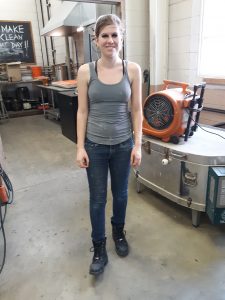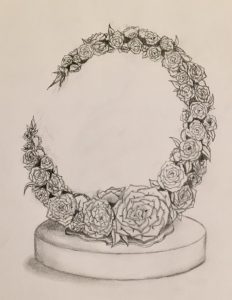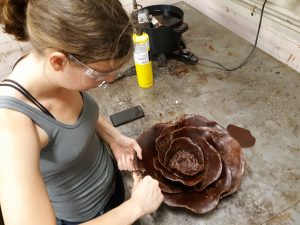
Ringo Lisko’s soft-petaled graphite proposal drawing barely disguises the fiery strength inherent in the bronze forms she’s now casting. Yet, her sculpture — an eight-foot circle of camellias in full bloom — fully embodies those seemingly contradictory characteristics of strength and delicacy. In fact, Lisko’s artistic purpose in part is to visually depict the contradictions inherent in forging a flower from metal in order to give the sculpture dynamic tension.
Lisko’s scale model design — one she created to work out any glitches before beginning the final full-size work — arcs up and over in a crescent, ending just before touching its beginning point below. “This point of tension,” Lisko wrote in her proposal, “works to add dynamism and energy to the otherwise steady and graceful piece, [a design] intended to embody the ideas of growth, connection and potential.”

Lisko’s design was selected to be the first created in the McMahon-Pleiad Public Art Trail initiative, a collaborative public sculpture project between UA, UAB and UAH.
The senior BFA major from New Mexico spent the summer carving and detailing each of the wax flowers (93 in all) that will be replicated in metal for the piece. From these, she created 93 individual molds that will become “lost” in the lost-wax process when she pours molten bronze into molds to cast the final forms. Once cast, Lisko will weld each camellia blossom onto an eight-foot-high semi-circular stainless steel framework.
The idea of a public art trail was conceived by three sculpture professors, Professor Craig Wedderspoon of UA, Assistant Professor Stacey Holloway of The University of Alabama at Birmingham’s department of art and art history and Assistant Professor Chris Taylor of The University of Alabama in Huntsville’s department of art, art history, and design. The UA Board of Trustees awarded the recently established McMahon-Pleiad Prize to the professors’ project, which carries with it $75,000 to create the sculptures. Once Lisko’s sculpture is completed, it will be installed on the UA campus in Tuscaloosa and eventually travel around the state to the other campuses. More sculptures, created at UAB and UAH, will follow in the coming years.

The goals of the McMahon-Pleiad Prize are to fund projects that advance the integrity and excellence of the System, incentivize innovation and promote unity among the UA System and its institutions.
“Camellias are Alabama’s state flower,” Lisko reminds a visitor, who is admiring the scale-model bronze circle of flowers. For Lisko, the flowers represent a “narrative of human potential—the potential to grow, love, and move forward,” as she wrote in her sculpture proposal. Those are ideals even higher than the UA System’s.
For more information about The University of Alabama’s programs in studio art and art history, visit our Degree Programs page.





